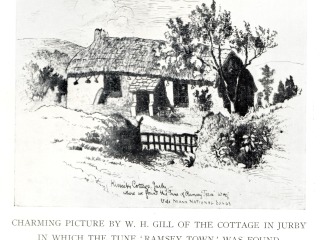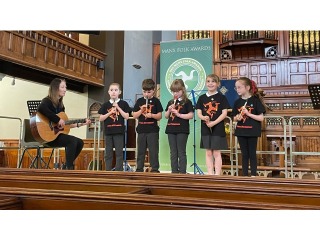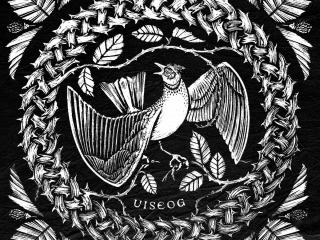MENU
03 Dec 2012
“WE ARE THE MOLLAG BAND”
Christmas-tide saw many itinerant groups out and about in the Isle of Man celebrating the holiday season: familiar are the White Boys and those on Hunt the Wren. Less familiar is the Mollag Band, though they are the one group well described by twentieth century collectors of folklore, notably Mona Douglas, Leighton Stowell, and W.W. Gill but not as such from earlier ones. It is just Dr John Clague who mentions them in the passage here published in 1911 but dating likely from the 1890s:
At Christmas time the Manx boys used to go about making a rough music with tin whistles, Jew’s-harps, tin-cans, and papered combs, and flourishing and thumping mollags—the sheepskin bladders which buoy the nets. This procession was called “the Mollag-band.” Faces were blacked or raddled, dress was eccentric, and coppers were not refused, but these street minstrels were quite distinct from the Wren-boys.
There is a lengthier and later description from W.W. Gill worth quoting in full:
The Christmastide “Mollag Bands,” like the Wren Boys and other ceremonial processions, descended in the course of time from men to boys before dying out altogether. My only recollection of the Mollag Band is that of an itinerant party of boys with blackened and raddled faces and eccentric attire, one or more waving and thumping with a mollag and all bellowing some popular song of the period. But I have been told by old residents that the Ramsey Mollag Band formerly consisted of fishermen, headed for a period by a big Irishman who swung his mollag at the end of a pole and swatted all who ventured too near. Some members of the old processions were dressed as women. The party used to go into shops and demand money, in addition to collecting coppers en route. They had a marching-song with English words.
This dates from 1933, and there are a number of points to be unpicked here. In order of Gill’s own comments, the Mollag Band was now one composed of adolescents having formerly been an adult phenomenon. They went about in disguise, a point made as seen by Clague. As they made their rounds, they made what was termed “rough music,” in other words, “disorganised music,” entering into another liminal zone (disguise the other). Their song repertoire was a current one showing the interaction of metropolitan culture with that of the Island. Then we have the observation that the Mollag Band formerly consisted of adult males, notably fisherman, a point picked up by other folklorists. Again, disguise, though on this occasion by reverse dressing. They collected money, or rather, demanded it. Finally, there was a specific song associated with them.
Turning to the adult phenomenon of the Mollag Band, they were as seen above all fisherman, and they have been sighted all over the Island: Castletown, Dalby, Douglas, Lezayre [sic], Maughold, Peel, and Ramsey (it is, however, with Castletown that the descriptive material is particularly rich). They went about as a party, in disguise as already mentioned, and with one of their members known as “The Fool” and variously named: “Bimbo” (Castletown); “Incabon” (Castletown); “Sambo” (Douglas & Ramsey); “Sonnys” (Dalby). This character in places was disguised apart from the rest of the band. In Castletown it was as a bear, in Dalby a pig (sonnys is Manx Gaelic for pig), in Maughold the Fool wore a whole sheepskin (complete with the horns), while in Douglas and Ramsey it was just a blackened face.
But not all Mollag Bands were in disguise according to descriptions provided by Mona Douglas. From an informant in Castletown, who also said that the band appeared after “Hunt the Wren” was finished, they were “dressed in tall hats and old tail coats and white trousers, generally a bit ragged and all decorated with holly and ivy and coloured ribbon or paper streamers.” Another mention by Douglas has them “dressed in white suits with long sleeveless coats and tall felt hats of blue, decorated with evergreens and paper streamers.”
All descriptions agree that they carried with them mollags (floats for fishing nets made from dog-skin) on the ends of poles—hence the name, of course, of the group—and as Douglas reports “with which they made passes at any person they met […].” Associated with the Mollag Band was both a song and a dance: “they performed a kind of marching dance with high leaps at intervals, to their own singing of a wild dance-tune.” She provides further information on this point:
The man who told me all this could not remember either the words of their song—they were Manx words though, he said—or the steps of the dance; but he hummed over the air for me, a variant of an old tune to Hunt the Wren, and said that they danced round in a circle in a peculiar spiral motion of the body, but separately not joining hands, and sometimes they leapt up all together and shouted.
As regards this dance:
I am inclined to think the dance [“The Salmon Leap”] virtually the same as […] The Mollag Dance, which belongs to Castletown, and was also formerly danced by fishermen, though later by men of the town. Here mollags slung on ropes were used to chase one dancer and imprison him, and although I have not got nearly such a complete description, certain features of the dance suggest the above. Both dances seem to have inspired great terror in all except those actually taking part in them.
This is one feature of the Mollag Band that must be noticed: whilst the White Boys and Hunt the Wren were welcomed customs, the Mollag Band was of a different nature: everything about them was liminal—disguised with blackened faces they dressed variously as women, animals, or reversed their clothing. Their music was rough in all senses of the word. They were aggressive and attacked bystanders with their mollags and they demanded money. Above all, they were fishermen on dry land and not at sea. Folk customs at times take one into a world turned upside down. Dark, anarchic of the established order, and above all, though just for a while on a sanctioned day, dangerous to the social order and above all the forces of authority.
This theme takes us to the only nineteenth century reporting of the Mollag Band we have to date and taken from the Manx Sun for 1892:
A Correspondent asks what has become of the “Mollag Band” this Christmas. They have certainly not been going about making the night hideous with song and revelry. I don’t know whether they have gone up aloft or migrated into some other sphere. My correspondent had better ask a policeman. He will be more likely to know.
Evidently, this is a report of what might be called the “junior” Mollag Band, the adolescents as mentioned by Clague rather than the adults of the other Mollag Band as described by later folklorists. Interesting is the mention of “better ask a policeman” as to where the Mollag Band were nowadays. In other words, they are under active suppression by the authorities as they seek to contain folk customs and make them passive and decorative rather than them being active and usurping of public space. This is taken up in a piece from 1914, in the Peel City Guardian:
Writing of Christmas reminds me of changes which have taken place in some respects in the manner of its observance. The “White Boys” and “The Mollag Band” have disappeared, and I think to a great extent the police are responsible for this.”
I have not heard any regrets expressed in consequence. Both institutions were an almost unmitigated nuisance, especially the “band.” Both parties used to walk into shops and take possession of them for a time, even on Christmas Eve, and render business impossible. And when they got into houses they often scared the younger children almost into fits.
They are gone, together with a lot of other outrages which used to be inflicted on the community—“jus’ for fun” in many cases, but in that of the “White Boys” and “The Mollag Band” for profit combined with fun. Peace to their ashes.
This does read as rather confused as regards the activities of the White Boys; all other accounts have them simply performing the Mummers Play in public houses and private households and not involving themselves as reported here in blockading access to shops for ransom. Nevertheless, it is an eyewitness account and must be taken into account. But returning to the Mollag Band, and here the “junior band,” we see again the mention of the police force as being a factor in the suppression of this calendar custom. The so-called rougher element associated with Hop-tu-Naa was similarly repressed in this period. The White Boys in Ramsey who sought to reform themselves after the end of the 1914–18 war were told they needed a Street Performers License in order to carry out their performances; the cost alone wiped out the money they were likely to earn. The Mollag Band is now gone from the streets of the Island and not one feels by their own choice. Vernacular culture is one always under threat of control if not downright suppression by the authorities, to be permitted only when it appears “folkloric,” in other words passive and decorative. The Mollag Band were unlikely ever to have become folkloric and that of course led to their ending.

'Ramsey Town - the Manx favourite sung with gusto island-wide'
23 Apr 2025
Read More...
Manx Folk Awards 2025 RESULTS
01 Apr 2025
Read More...
Little Red Bird - the island's most popular and well-travelled lullaby
31 Mar 2025
Read More...
Contact, Links, Acknowledgements, Privacy
© Culture Vannin. Culture Vannin is the trading name for the Manx Heritage Foundation, registered charity 333 in the Isle of Man. Designed by 3 Legs Ltd.